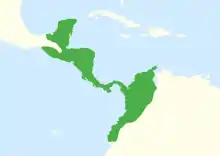| Central American agouti | |
|---|---|
_Los_Tarrales.jpg.webp) | |
| Suchitepéquez Department, Guatemala | |
| Scientific classification | |
| Domain: | Eukaryota |
| Kingdom: | Animalia |
| Phylum: | Chordata |
| Class: | Mammalia |
| Order: | Rodentia |
| Family: | Dasyproctidae |
| Genus: | Dasyprocta |
| Species: | D. punctata |
| Binomial name | |
| Dasyprocta punctata (Gray, 1842) | |
 | |
The Central American agouti (Dasyprocta punctata) is a species of agouti from the family Dasyproctidae.[2] The main portion of its range is from Chiapas and the Yucatan Peninsula (southern Mexico), through Central America, to northwestern Ecuador, Colombia and far western Venezuela. A highly disjunct population is found in southeastern Peru, far southwestern Brazil, Bolivia, western Paraguay and far northwestern Argentina. The disjunct population has been treated as a separate species, the brown agouti (Dasyprocta variegata),[3] but a major review of the geographic variation is necessary.[2] The Central American agouti has also been introduced to Cuba and the Cayman Islands.[2][4]
Though some populations are reduced due to hunting and deforestation, large populations remain[3] and it is not considered threatened.[1]
In an analysis of 240 species, agoutis came in fourth place for best sense of smell; better than dogs, which actually came out average. Their snouts are packed full of olfactory receptors.[5]
Appearance
Central American agoutis from the main part of their range weigh 3–4.2 kg (6.6–9.3 lb) and are typically reddish, orange or yellowish grizzled with black.[3][6] In northern Colombia, western Venezuela, and on the Atlantic slope of Costa Rica and Panama the foreparts are brownish or blackish grizzled with tawny or olivaceous, the mid-body is orange, and the rump is black or cream.[3][6] In western Colombia and Ecuador some have tawny foreparts and yellowish to the rump.[3] Agoutis from the disjunct southern population (Peru, Brazil, Bolivia, Paraguay and Argentina) which sometimes are treated as a separate species, Dasyprocta variegata, weigh 3–5.2 kg (6.6–11.5 lb) and are grizzled brown, yellowish and black, or grizzled black and orange.[3]
Behavior
Like other agoutis, Central American agoutis are diurnal and live in monogamous pairs.[6] They mainly feed on fruits and seeds, and are important seed dispersers.[7]
References
- 1 2 Emmons, L. (2016). "Dasyprocta punctata". IUCN Red List of Threatened Species. 2016: e.T89497686A78319610. doi:10.2305/IUCN.UK.2016-2.RLTS.T89497686A78319610.en. Retrieved 13 November 2021.
- 1 2 3 Woods, C.A.; Kilpatrick, C.W. (2005). "Infraorder Hystricognathi". In Wilson, D.E.; Reeder, D.M (eds.). Mammal Species of the World: A Taxonomic and Geographic Reference (3rd ed.). Johns Hopkins University Press. p. 1558. ISBN 978-0-8018-8221-0. OCLC 62265494.
- 1 2 3 4 5 6 Emmons, L. H. (1997). Neotropical Rainforest Mammals. Pp. 227-229. 2nd edition. ISBN 0-226-20721-8
- ↑ Long, J. L. (2003). Introduced Mammals of the World: Their History, Distribution and Influence. Csiro Publishing, Collingwood, Australia. ISBN 9780643099166
- ↑ "Scientists studied the DNA of 240 different animals. Here are some of the quirkiest findings". www.wbur.org.
- 1 2 3 Reid, F. A. (1997). Mammals of Central America and Southeast Mexico. Pp. 243-244. ISBN 0-19-506400-3
- ↑ Less, E.; Ojeda, R.; Bidau, C.; Timm, T.; Samudio, R. & Emmons, L. (2008). "Dasyprocta punctata". IUCN Red List of Threatened Species. 2008. Retrieved 5 January 2009.
External links
- Decker, J. 2000. "Dasyprocta punctata", Animal Diversity Web. Accessed November 26, 2008
